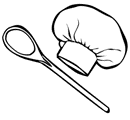Category: "Asian"
Shan yao

As an ingredient for a recipe the other day, I picked up shan yao, which is a member of the yam family. Pretty scary looking, huh? What's scarier is that when you peel it, it develops vile white mucilaginous strings, and it becomes as slippery as a greased pig in a tub of lard. Why the heck am I cooking with this grotesque vegetable? Well, I was supposed to buy dried shan yao, but the closest Asian store only had the raw item. I only needed a half cup of the raw, so I was left with this huge tuber that I paid too much money for. I just can't throw it out. All my Scottish ancestors would rise from their graves and curse me for a spendthrift. I searched the web up and down for recipes that use it, but the only ones I could find involved lots of other carbs, which just won't fly with my current food Nazi diet, or they were in soups, which are notoriously hard to count for calories unless they are a homogenous purée, which these soups weren't. One web page suggested they be cooked like potatoes. With that clue I decided to apply my brother-in-law's approach to making oven-baked potatoes.
Here are the instructions to duplicate what I did.
Baked shan yao
- Pre-heat oven to 400°.
- Wash and peel the tuber.
- Slice it in half lengthwise, and then slice each resulting half lengthwise as well.
- Cross cut the tuber into pieces about 3/8" thick. You'll end up with a bunch of wedge-shaped chunks
- Lightly oil a foil-lined baking pan. Distribute the chunks on it. Sprinkle with salt and pepper to taste. Sprinkle the left side of the pan with garlic powder, and the right side with chile powder. (I like the varying tastes.)
- Place in oven for 40 minutes. Remove and serve.

To my great pleasure, the resulting wedges tasted good. They weren't slimy at all. The insides weren't quite as dry and flaky, say, as Russet potatoes would have been, which makes sense since the tuber seems slightly moister than a standard potato, but again the texture was perfectly pleasant.
The Wikipedia article on shan yao states that it has 65 kilocalories per 100 grams of raw tuber, which makes it somewhat less calorically dense than Russets, thus it's fine for occasionally consumption in moderation.
Kombu
Today I cooked my first recipe with kombu. Kombu is the Japanese name of a sea vegetable mentioned in the recipe I wanted to make. I wasn't confident that I could find it. Oh, sure, there are Asian stores here in Phoenix, but have you ever been in an Asian store??? All sorts of things are labeled in Thai, Japanese, Korean and Chinese, and I'm a total gringo who has never studied an Asian language. So before I shopped I went to Wikipedia and looked up kombu. Down the road there is a store that seems to be run by Korean people, so I wanted, among other things, to figure out that Korean characters for whatever the Korean equivalent to kombu was.
Go figure, right off the bat the Wikipedia article mentions that the Korean equivalent of kombu is dashima. I copied down the Korean characters and went to the store. In the seaweed section I found packages that seemed to have something sort of like the Korean characters, but I wasn't entirely confident. Up the row walked an Asian couple. The man approached first, so I asked him about kombu/dashima. He looked confused and said to ask his wife. Fortunately she had a much thicker accent and knew exactly what I was talking about. “Oh, yes, this is dashima. Are you making soup?” I said 'yes,' although chile is not exactly soup, but I had read that kombu's main purpose in Japanese cooking was for soup base. Then she pointed out the ugliest package of dashima I could imagine. “This looks like good dashima.” Yuck! But of course I'm not stupid enough to think that things that look like good pre-packaged assinine Yankee products necessarily taste the best, so I bought what she pointed out. (Picture attached.) It's so nice when complete strangers are so nice to you, even though there spouses are monolingual gringo-equivalents.

